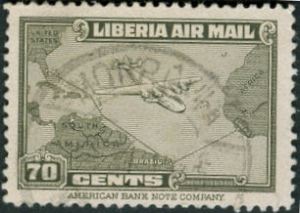Liberia, Scott C43, 1942, 39mm x 24mm
Once again we have a stamp issue commemorating the air supply route from North America via South America to western Africa in the middle of World War II. Only three countries are depicted (the United States, Brazil, and the issuing country of Liberia). An outsized 4-engine transport plane (possibly a C-108 Flying Fortress) is shown alongside the coast-hugging path southward.
I am not sure that the business of transport is considered to have enough charisma to show up much on stamps nowadays, relatives to the most popular topicals.






